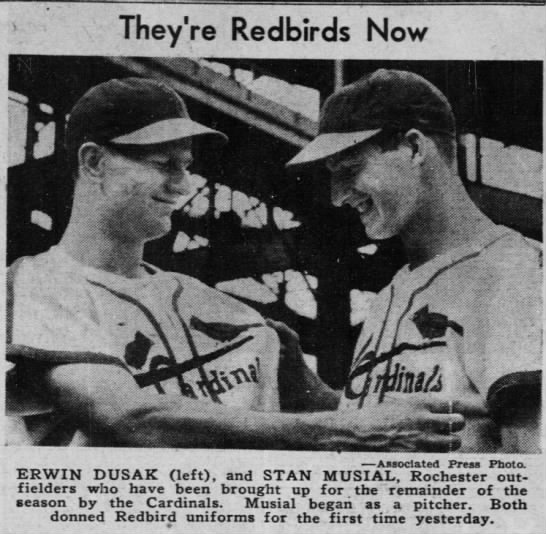|
I didn’t remember, until a nice guy named Bob sent me a link that noted the 75th anniversary of Stan Musial’s first game, Sept. 17, 1941.
This reminded me that baseball -- for all the steroids and designated hitters and the deafening blare of ball-park commercials – is pretty much the same game. Teams battle all season, and then in September new boys come along to alter the pennant race. You never know. In New York this week, the Mets won a game because an obscure callup named T.J. Rivera, out of the Bronx, hit a home run, and the Yankees almost won a game as a recently dismissed hitter named Billy Butler flew across the country to drive in runs in his first game. Shades of Stan Musial, now known as a career .331 hitter but in 1941 not known at all, even in St. Louis. He was just a kid called up from Rochester because a few Cardinals were hurt as the team tried to catch the Brooklyn Dodgers. My Brooklyn Dodgers. I was 2, but I was rooting. Years later, our fans would dub him “Stan the Man.” He moidered us, but we loved him all the same. Nobody knew him when he came up. There was no web-o-sphere, no blab-o-sphere. He just showed up in St. Louis, as ordered, took the uniform No. 6 (he was not a star prospect, but the uniform was available) and in the second game of a doubleheader he tried to hit Jim Tobin, a pitcher known as Abba-Dabba because his knuckleball fluttered with occult mystery. Musial popped up the first time but then calibrated for a double and single and two runs-batted in. The Cardinals didn’t catch the Dodgers, but Musial pretty much hit like that right through 1963. The Boston Braves’ manager, named Charles Dillon Stengel, was so jealous of the new talent that he kept telling people, “They got another one,” or words to that effect. Thus was born one of baseball’s most beautiful bromances, two men who positively adored each other for life, but never got to work together. The Cardinals loved the kid’s swing, and decided they shouldn’t run him out of the batting cage, the way veterans did. On a subsequent train ride, Terry Moore, one of the great baseball captains, sat next to Musial in the parlor car and asked him who he was, and Musial said he was the lefty whom the varsity had bombarded in a spring-camp game. Right, he started the year as a rag-arm pitcher. It’s all in the biography I did about Musial, “Stan Musial, an American Life,” published in 2011. Musial passed in January of 2013 and I wrote about him in the Times -- the 475 homers, the exact same batting average at home and on the road, the friendship with John F. Kennedy, the identification with his hard-times home town, Donora, Pa., and his adopted home of St. Louis, where he could be his aw-shucks self. Players still come up in September and perhaps affect pennant races, but not necessarily anybody quite like Stan the Man. * * * Musial’s first box score: http://www.retrosheet.org/boxesetc/1941/B09172SLN1941.htm The link in the web site of the St. Louis Post-Dispatch: https://stltoday.newspapers.com/clip/4562936/sept_17_1941_stan_musials_first/
Brian Savin
9/17/2016 06:14:29 am
My goodness, Stosh played his first game eight years to the day before I was born. Yet I remember so well following his career and trading for his baseball card. I liked when baseball was important to growing up and when quality players were quality people too.
George Vecsey
9/17/2016 09:56:03 am
Brian, I just lucked out, that this nice guy named Bob sent me the link. 10/6/2016 03:39:13 am
Now the resource of moviestarplanet game can easily accessible using online vip moviestar planet generator. look more for moviestarplanet game hack. Comments are closed.
|
Categories
All
|










